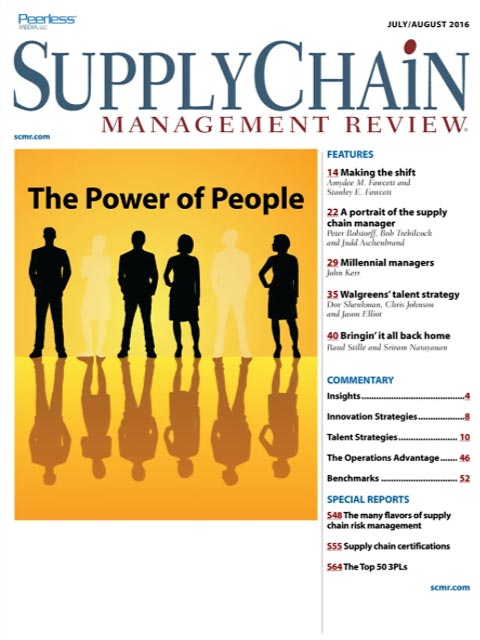Sorry, but your login has failed. Please recheck your login information and resubmit. If your subscription has expired, renew here.
July-August 2016
What’s the difference between us and our competitors? Our people!” I can’t think of an organization that doesn’t publicly state that its people are its most important asset. Yet, anyone who has been in the workforce for any length of time knows that when the rubber hits the road—or something else hits the fan—people are usually the first casualty of cost cutting. It’s far easier to free up your talent for “other opportunities” than it is to close a plant or sell a fleet of trucks. Browse this issue archive.Need Help? Contact customer service 847-559-7581 More options
Two years ago I began writing about retail e-commerce, mainly highlighting the struggles that brick-and-mor¬tar retailers have had competing against the likes of Amazon.com. Amazon succeeded in being the “Wal-Mart of the Internet” by innovating a supply chain designed to dominate large-scale, on-line, unit-based order fulfillment. My two columns on the subject were: “Holiday e-commerce: Innovation required” (Jul/Aug 2014) and “e-commerce innovation needed by retailers” (Mar/Apr 2015).
The big e-story these days is omni-channel retail supply chains. Consultants and software companies have been aggressively marketing their wares largely to business-to-consumer (B2C) supply chains. But, what about business-to-business (B2B) supply chains? More importantly, what about hybrid B2B and B2C chains? Surely (by definition) these, too, are omni-channel.
The e-business book
The only book project I was ever a part of was as a co-author of a book written by AMR Research (now part of Gartner Inc.) and Computer Sciences Corporation (CSC). Commissioned in April 2000 by the Council of Logistics Management (CLM), now the Council of Supply Chain Management Professionals (CSCMP), our job was to provide practical advice to its members about leveraging the Internet. The research added to the knowledge our organizations previously had on where things were headed. The book had two themes:
- Internet leverage. How companies were leveraging the Internet and electronic connectivity to support and enhance current supply chain management processes and practices.
- New business models. What leading companies were doing to align their supply chains in support of new e-business models for conducting business over the Web, including internal productivity enhancements and external benefits.
 |
This complete article is available to subscribers
only. Click on Log In Now at the top of this article for full access. Or, Start your PLUS+ subscription for instant access. |
SC
MR
Sorry, but your login has failed. Please recheck your login information and resubmit. If your subscription has expired, renew here.
July-August 2016
What’s the difference between us and our competitors? Our people!” I can’t think of an organization that doesn’t publicly state that its people are its most important asset. Yet, anyone who has been in the… Browse this issue archive. Access your online digital edition. Download a PDF file of the July-August 2016 issue. |
Download Article PDF |
Two years ago I began writing about retail e-commerce, mainly highlighting the struggles that brick-and-mor¬tar retailers have had competing against the likes of Amazon.com. Amazon succeeded in being the “Wal-Mart of the Internet” by innovating a supply chain designed to dominate large-scale, on-line, unit-based order fulfillment. My two columns on the subject were: “Holiday e-commerce: Innovation required” (Jul/Aug 2014) and “e-commerce innovation needed by retailers” (Mar/Apr 2015).
The big e-story these days is omni-channel retail supply chains. Consultants and software companies have been aggressively marketing their wares largely to business-to-consumer (B2C) supply chains. But, what about business-to-business (B2B) supply chains? More importantly, what about hybrid B2B and B2C chains? Surely (by definition) these, too, are omni-channel.
The e-business book
The only book project I was ever a part of was as a co-author of a book written by AMR Research (now part of Gartner Inc.) and Computer Sciences Corporation (CSC). Commissioned in April 2000 by the Council of Logistics Management (CLM), now the Council of Supply Chain Management Professionals (CSCMP), our job was to provide practical advice to its members about leveraging the Internet. The research added to the knowledge our organizations previously had on where things were headed. The book had two themes:
- Internet leverage. How companies were leveraging the Internet and electronic connectivity to support and enhance current supply chain management processes and practices.
- New business models. What leading companies were doing to align their supply chains in support of new e-business models for conducting business over the Web, including internal productivity enhancements and external benefits.
 |
SUBSCRIBERS: Click here to download PDF of the full article. |
SC
MR

Latest Supply Chain News
Latest Podcast

 Explore
Explore
Latest Supply Chain News
- 2024 Warehouse/DC Operations Survey: Technology adoption on the rise
- Benchmarking the complexity of ESG reporting
- Looking back at NextGen 2024
- The Corporate Sustainability Due Diligence Directive
- How to make your CFO a supply chain superfan
- AI is moving omnichannel closer to the customer
- More latest news
Latest Resources

Subscribe

Supply Chain Management Review delivers the best industry content.

Editors’ Picks





